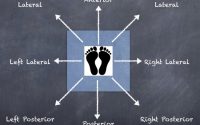3 Steps to a Functional Foot Assessment
A functional foot assessment is something you could write a book on, so this is a quick hitter of strategies to narrow the focus a little for this blog post. So I think I’ll focus on what I do the first time I see a patient, what do I do to get an idea about someones foot function? I’d break it down into 3 stages:
- Off weight bearing assessment
- Functional isolated assessment
- Functional integrated assessment
Off Weight Bearing
I always start with this (unless I saw something when they walked in) because the patient can relax and get used to being in the clinic and it’s easy for them. It also gives you lots of information that may come in handy once you are watching them move. I go through simple passive range of the sub-talar (STJ), talo-crural (TCJ) and mid-tarsal joints (MTJ to get a feel of what they have to offer…where are the restrictions/laxity etc.
Then I start to combine the motions, STJ eversion with MTJ inversion and vice versa, then I check the ‘locking mechanism’ of the MTJ. I put the STJ in eversion and assess MTJ mobility then invert the STJ and compare MTJ motion, obviously it should be significantly less…particularly on the calcaneo-cuboid joint.
At this point I’m just gathering information, what does the foot like, what doesn’t it like, how much inversion does it take to ‘lock’ the MTJ? Just keep all that info in your head and get them up for some movement assessments
- Functional Isolated
No special attachment to the name…couldn’t think of anything better! It obviously depends exactly on what injury they have as to exactly what, but in the majority of cases I get them standing and ask them to 90% weight bear on one foot, and to start with they can hold onto something for balance. I then ask them to squat on the weight bearing foot to full range. I mainly focus on the foot and ankle at this point, looking for ROM and can the foot get into eversion and back out.
- Functional Integrated
This is usually as far as I get on the first assessment, it’s really progression of functional isolated assessment. I take away the stability, first the hands then the 10% weight bearing from the other foot. I re-assess range and load explode at each stage to compare. This tells me how much joint range they have and then how willing is their body to let them use that range (This is very important…more important than ROM). And that’s it…I have plenty of info to get me started.
So what do I find?
To keep it brief I’ll go through my common findings, joint by joint:
MTJ
Again, there is a lot to this, these are just the most common ideas. If it’s abnormal, it will either not lock, not lock until end range STJ inversion (which you don’t get in gait) or the other extreme is that the MTJ is stiff and effectively won’t unlock.
STJ
Most commonly, limited in eversion. very common because most people will have sprained their ankle at some stage of their life…worth checking the tib/fib joints at this point too, often disrupted with ankle sprains/fractures.
Also, often get laxity in inversion if they have sprained it a lot.
TCJ
If the other joints have been stiff for a long time you will get limited dorsiflexion at the TCJ, working on the other joints will get back a lot of dorsi, but to get full range back go to end range dorsi and drive all the different foot motions, like in the dorsiflexion matrix.
**Sorry for the weird stretched out video!!**
Like I said…you can write a book on this, so I hope you find these quick hitters are useful. Please click below to share this post if you liked it…Thanks
Physioblogger


